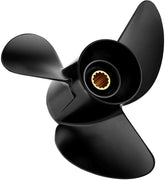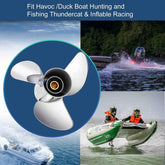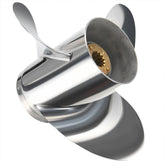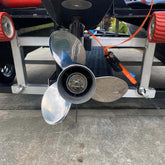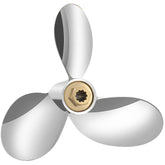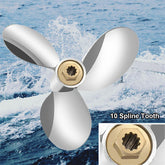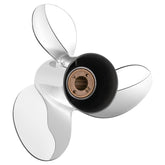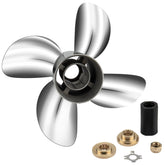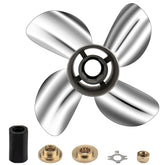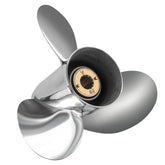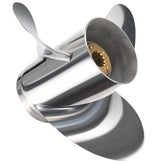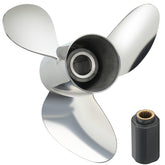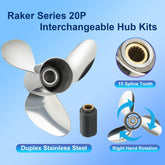Yamaha vs Mercury Propellers — Which Fits Your Boat?
If your goal is predictable performance and fewer returns, treat a prop swap like an engineering job—not a shopping sprint. This short, practical guide walks you through the decisive checks that tell whether a Yamaha prop will work on a Mercury lower unit (or vice versa), what compromises adapters introduce, and the production-backed options VIF offers so you can order a reliable replacement fast.
Gather three facts before you shop
Most failed swaps come from missing data. Photograph and record these before you place an order or cut an adapter:
-
Prop stamp (diameter × pitch) — often stamped on the hub or blade (example:
13 x 19). -
Hub / spline detail — clear photo of the prop hub interior and the lower-unit input shaft (or part numbers).
-
Engine ID & WOT RPM — engine make/model/year/serial and a wide-open-throttle RPM taken under a typical load (people + fuel + gear).
Send those items with any request on our store (vifprop.com) and you remove most guesswork up front.
Mechanical fit is step one: hub & spline
The logo doesn’t matter if the spline doesn’t match.
-
Spline count/profile must match. If it doesn’t, the prop either won’t seat or will transfer torque poorly.
-
Hub swaps are viable only when the prop body was designed for a replaceable hub. A hub swap keeps a prop you like but fits it to a different lower unit.
-
Adapters exist but introduce axial/radial offsets and altered torque paths. They’re acceptable for occasional, light-duty use—avoid them for towing, commercial work or frequent full-throttle runs.
If you want ready-made Yamaha replacements, check our Yamaha listings (e.g., propellers for Yamaha); for Mercury owners we maintain corresponding collections as well.
Diameter × pitch: validate with RPM, don’t guess
Diameter and pitch control engine loading. The engineering rule is simple:
-
Record baseline WOT RPM on your boat with the current prop and typical load.
-
Compare to the engine maker’s recommended WOT band.
-
If WOT is above the band → prop too small (pitch too low); increase pitch.
-
If WOT is below the band → prop too large (pitch too high); reduce pitch.
Change pitch in small steps (±1–2 inches) and retest under the same load and trim. That iterative test is how you balance hole-shot, cruise efficiency and top speed without overstressing the engine.
Material & blade count — match the mission
-
Aluminum: cost-effective, repairable after light strikes — good for recreational use.
-
Stainless steel: allows thinner, stiffer blades for better high-RPM efficiency and top speed — preferred for high-power or performance needs.
-
3-blade vs 4-/5-blade: 3-blade is the everyday compromise; 4-blade gives better low-end thrust and loaded handling; 5-blade is niche (extreme towing or stability).
VIF manufactures precision aluminum and stainless propellers and can recommend the best combo for your engine and load profile. Browse performance and hot-selling models (YBS, Chopper, Vengeance) in our hot-selling collection.
Three practical replacement routes
When mixing Yamaha and Mercury hardware, choose one of these based on risk tolerance and intended use:
-
Direct fit (best-case) — same spline/profile and clearance. Fit, then verify WOT RPM. If it works, you’re done.
-
OEM hub swap — replace the hub to match the lower unit while keeping the prop body. Use this only if the prop is designed for hub replacement.
-
Custom prop built to your spline (recommended for reliability) — manufacture the blade with the exact spline/profile and tuned pitch for your lower unit. This removes adapter-related offsets and is the long-term reliable solution.
For heavy-duty, high-hour service or towing, VIF recommends the custom prop route.
Installation & verification checklist (field steps)
-
Inspect and photograph splines, hub rubber and shaft runout before installation.
-
Use matched hardware (prop nut, washer, cotter pin). VIF supplies hardware kits to ensure compatibility.
-
Initial run: idle → low speed → WOT; record RPM, trim and load.
-
If WOT is out of band, iterate pitch changes and retest. If vibration appears, stop and inspect hub, shaft runout and blades.
Real failures that masquerade as performance problems
-
New vibration after swap — often hub rubber deterioration, slight shaft bend or spline wear, not necessarily blade geometry.
-
Lower top speed with higher fuel burn — usually a pitch mismatch or damaged blades.
-
Slippage under load — worn or mismatched hub; replace hub or use a true direct-fit prop.
Why factory capability matters
VIF integrates R&D, tooling and production, so we can produce a propeller that fits mechanically and performs to spec. If you want to understand how propellers are manufactured and what our factory can do, read our production overview: How Boat Propellers Are Manufactured. That capability lets us deliver matched hardware and water-pump repair kits along with the prop — a one-stop replacement.
What to send for a fast, precise quote
Include these on your order page or email:
-
Engine brand/model/year/serial
-
Clear photos: prop stamp, prop hub interior, lower unit input shaft
-
Current WOT RPM and typical load (people + gear)
-
Desired outcome (better acceleration, higher top speed, towing)
-
Delivery country & contact
Place orders or upload specs at our online store: VIF Propeller Online Store. For Yamaha-specific replacements use the Yamaha collection: propeller for Yamaha; Honda, Volvo and other brand pages are available in our collections if you want a brand-specific search.
Short closing — practical, not promotional
A prop decision is engineering first: confirm spline fit, tune diameter/pitch by RPM testing, then select material and blade count to match duty. If you prefer avoiding adapters and the risk they introduce, send your photos and specs to VIF — we’ll return engineer-rated options (direct-fit, hub-swap, and custom) plus the exact hardware you need to install them.
Order / Quote: https://vifmarine.com — include photos and WOT RPM for the fastest, safest match.


